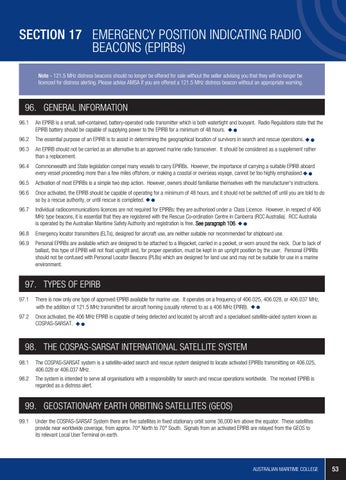Section 17 Emergency Position Indicating Radio Beacons (EPIRBs) note - 121.5 MHz distress beacons should no longer be offered for sale without the seller advising you that they will no longer be licenced for distress alerting. Please advise AMSA if you are offered a 121.5 MHz distress beacon without an appropriate warning.
96. General Information 96.1
An EPIRB is a small, self-contained, battery-operated radio transmitter which is both watertight and buoyant. Radio Regulations state that the EPIRB battery should be capable of supplying power to the EPIRB for a minimum of 48 hours.
96.2
The essential purpose of an EPIRB is to assist in determining the geographical location of survivors in search and rescue operations.
96.3
An EPIRB should not be carried as an alternative to an approved marine radio transceiver. It should be considered as a supplement rather than a replacement.
96.4
Commonwealth and State legislation compel many vessels to carry EPIRBs. However, the importance of carrying a suitable EPIRB aboard every vessel proceeding more than a few miles offshore, or making a coastal or overseas voyage, cannot be too highly emphasised.
96.5
Activation of most EPIRBs is a simple two step action. However, owners should familiarise themselves with the manufacturer's instructions.
96.6
Once activated, the EPIRB should be capable of operating for a minimum of 48 hours, and it should not be switched off until you are told to do so by a rescue authority, or until rescue is completed.
96.7
Individual radiocommunications licences are not required for EPIRBs: they are authorised under a Class Licence. However, in respect of 406 MHz type beacons, it is essential that they are registered with the Rescue Co-ordination Centre in Canberra (RCC Australia). RCC Australia is operated by the Australian Maritime Safety Authority and registration is free. See paragraph 106.
96.8
Emergency locator transmitters (ELTs), designed for aircraft use, are neither suitable nor recommended for shipboard use.
96.9
Personal EPIRBs are available which are designed to be attached to a lifejacket, carried in a pocket, or worn around the neck. Due to lack of ballast, this type of EPIRB will not float upright and, for proper operation, must be kept in an upright position by the user. Personal EPIRBs should not be confused with Personal Locator Beacons (PLBs) which are designed for land use and may not be suitable for use in a marine environment.
97. Types of EPIRB 97.1
There is now only one type of approved EPIRB available for marine use. It operates on a frequency of 406.025, 406.028, or 406.037 MHz, with the addition of 121.5 MHz transmitted for aircraft homing (usually referred to as a 406 MHz EPIRB).
97.2
Once activated, the 406 MHz EPIRB is capable of being detected and located by aircraft and a specialised satellite-aided system known as COSPAS-SARSAT.
98. The COSPAS-SARSAT International Satellite System 98.1 The COSPAS-SARSAT system is a satellite-aided search and rescue system designed to locate activated EPIRBs transmitting on 406.025, 406.028 or 406.037 MHz. 98.2
The system is intended to serve all organisations with a responsibility for search and rescue operations worldwide. The received EPIRB is regarded as a distress alert.
99. Geostationary Earth Orbiting Satellites (GEOS) 99.1 Under the COSPAS-SARSAT System there are five satellites in fixed stationary orbit some 36,000 km above the equator. These satellites provide near worldwide coverage, from approx. 70° North to 70° South. Signals from an activated EPIRB are relayed from the GEOS to its relevant Local User Terminal on earth.
AUSTRALIAN MARITIME COLLEGE
53
